The Tabernacle Choir At Temple Square
Brief History - 23 March, 2024
Brief History - 23 March, 2024
Top | Home | Frequently Asked Questions | Guestbook
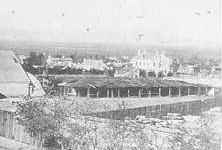 The Mormon Tabernacle choir first sang on August 22, 1847
(twenty-nine days after the pioneers had entered the Salt Lake Valley)
at the first General Conference to be held in Utah. This conference
met in a 28' x 40' "Bowery" with adobe walls and brush and earth roof.
Three successively larger boweries replaced the first one.
The Mormon Tabernacle choir first sang on August 22, 1847
(twenty-nine days after the pioneers had entered the Salt Lake Valley)
at the first General Conference to be held in Utah. This conference
met in a 28' x 40' "Bowery" with adobe walls and brush and earth roof.
Three successively larger boweries replaced the first one.
John Parry, conductor (1849-1854)
In 1849 Brigham Young invited Welsh convert John Parry to organize a choir for the next general conference, and this choir formed the nucleus around which the church's choral tradition grew.
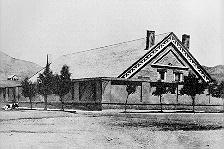 The first, or "Old," Tabernacle was completed in 1851.
The first, or "Old," Tabernacle was completed in 1851.
Stephen H. Goddard, conductor (1854-1856)
James Smithies, conductor (1856-1862)
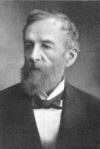 A small organ handcrafted in Australia and brought to Utah
by Joseph Ridges was installed in 1857.
Karl G. Maeser, Fannie Young Thatcher, Sarah Coke, Orson Pratt, Jr.,
and John M. Chamberlain served as organists in the "Old" Tabernacle.
A small organ handcrafted in Australia and brought to Utah
by Joseph Ridges was installed in 1857.
Karl G. Maeser, Fannie Young Thatcher, Sarah Coke, Orson Pratt, Jr.,
and John M. Chamberlain served as organists in the "Old" Tabernacle.
John M. Chamberlain wrote the words and music to the hymn, "We Are Marching On To Glory" (Hymns, number 225, 1985).
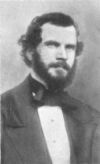 Charles John Thomas, conductor (1862-1865)
Charles John Thomas, conductor (1862-1865)
Robert Sands, conductor (1865-1869)
 In October, 1867 the present dome-roofed Tabernacle was completed,
including a new and larger organ built by Joseph Ridges and Niels Johnson.
In October, 1867 the present dome-roofed Tabernacle was completed,
including a new and larger organ built by Joseph Ridges and Niels Johnson.
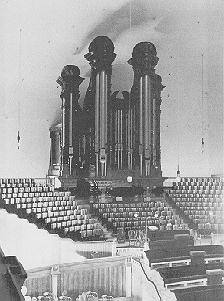 The Ridges organ had 2,000 pipes.
The most notable feature from pioneer days is the central portion
of the large organ case. The famous golden pipes, made of wood staves
fashioned from Utah timber, still play today.
The Ridges organ had 2,000 pipes.
The most notable feature from pioneer days is the central portion
of the large organ case. The famous golden pipes, made of wood staves
fashioned from Utah timber, still play today.
October 6, 1867, the choir of 150 voices sang for the sessions of
the Church Conference, accompanied by the new organ, at that time
the largest in America.
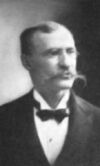 Joseph J. Daynes, the first Tabernacle organist (1867-1900).
Joseph J. Daynes, the first Tabernacle organist (1867-1900).
- Joseph J. Daynes wrote many hymns, including the following:
- "Come, Listen to a Prophet's Voice", (music) (Hymns, number 21, 1985).
- "Now We'll Sing with One Accord", (music) (Hymns, number 25, 1985).
- "Great God, Attend While Zion Sings", (music) (Hymns, number 88, 1985).
- "Lord, Accept Our True Devotion", (music) (Hymns, number 107, 1985).
- "As the Dew from Heaven Distilling", (music) (Hymns, number 149, 1985), which has been used at the close of many Choir broadcasts.
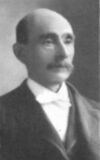 George Careless, conductor (1869-1880)
George Careless, conductor (1869-1880)
In 1869, English convert George Careless, a professional musician from London, was appointed director of the choir.
- George Careless wrote a number of hymns, including:
- "The Morning Breaks", (music) (Hymns, number 1, 1985).
- "Arise, O Glorious Zion", (music) (Hymns, number 40, 1985).
- "Though Deepening Trials", (music) (Hymns, number 122, 1985).
- "Prayer Is the Soul's Sincere Desire", (music) (Hymns, number 145, 1985).
- "O Thou Kind and Gracious Father", (music) (Hymns, number 150, 1985).
- "O Lord of Hosts", (music) (Hymns, number 178, 1985).
- "Again We Meet Around the Board", (music) (Hymns, number 186, 1985).
- "Behold The Great Redeemer Die", (music) (Hymns, number 191, 1985).
- "He Died! The Great Redeemer Died", (music) (Hymns, number 192, 1985).
July 4, 1873, the first Tabernacle Choir concert was presented in the Tabernacle.
Ebenezer Beesely, conductor (1880-89), with Thomas C. Griggs, assistant.
- Ebenezer Beesely wrote numerous hymns, including:
- "High on the Mountain Top", (music) (Hymns, number 5, 333, 1985).
- "What Glorious Scenes Mine Eyes Behold", (music) (Hymns, number 16, 1985).
- "The Happy Day at Last Has Come" (music) (Hymns, number 32, 1985), which was the Belgium Antwerp mission song when I served there.
- "God of Our Fathers, We Come unto Thee", (music) (Hymns, number 76, 1985).
- "Great Is the Lord", (music) (Hymns, number 77, 1985).
- "Sing We Now at Parting", (music) (Hymns, number 156, 1985).
- "'Tis Sweet to Sing the Matchless Love", (music) (Hymns, number 177, 1985).
- "Revrently And Meekly Now", (music) (Hymns, number 185, 1985).
- "Let Us Oft Speak Kind Words", (music) (Hymns, number 232, 1985).
- "Welcome, Welcome, Sabbath Morning", (music) (Hymns, number 280, 1985).
- "We Meet Again in Sabbath School", (music) (Hymns, number 282, 1985).
Neils Johnson enlarged the organ in 1885.
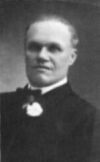 Evan Stephens, Director (1890-1916), with Horace S. Ensign, assistant.
Evan Stephens, Director (1890-1916), with Horace S. Ensign, assistant.
- Evan Stephens wrote many hymns, including:
- "What Was Witnessed in the Heavens?", (music) (Hymns, number 11, 1985).
- "Awake, Ye Saints of God, Awake!", (music) (Hymns, number 17, 1985).
- "The Voice of God Again Is Heard", (text and music) (Hymns, number 18, 1985).
- "We Ever Pray for Thee", (text and music) (Hymns, number 23, 312, 1985).
- "Our Mountain Home So Dear", (music) (Hymns, number 33, 1985).
- "For the Strength of the Hills", (music) (Hymns, number 35, 1985).
- "Lo, the Mighty God Appearing", (music) (Hymns, number 55, 1985).
- "Raise Your Voices to the Lord", (text and music) (Hymns, number 61, 1985).
- "Praise Ye the Lord", (music) (Hymns, number 74, 1985).
- "Father, Thy Children to Thee Now Raise", (text and music) (Hymns, number 91, 1985).
- "Ye Simple Souls Who Stray", (music) (Hymns, number 118, 1985).
- "Lean on My Ample Arm", (music) (Hymns, number 120, 1985).
- "In Rembrance of Thy Suffering", (text and music) (Hymns, number 183, 1985).
- "Today, While the Sun Shines", (music) (Hymns, number 229, 1985).
- "Let Us All Press On", (text and music) (Hymns, number 243, 1985).
- "True To The Faith", (text and music) (Hymns, number 254, 1985).
- "See the Mighty Angel Flying", (music) (Hymns, number 330, 1985).
- "O Home Beloved", (text) (Hymns, number 337, 1985).
During his tenure, Evan Stephens increased the size of the choir from about 125 to more than 300.
The Mormon Tabernacle Choir, under the direction of Evan Stephens, with soloists Robert C. Easton, Nellie Druce-Pugsley, and others, won second place in the competition for the Eisteddfod International Prize at the 1893 Columbian World's Fair in Chicago.
On February 11, 1895, the First Presidency of the Church declares the Tabernacle Choir members to be "acting as missionaries", and to consider their choir duties as their primary public duty.
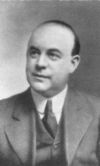 John J. McClellan, Organist (1900-1925)
John J. McClellan, Organist (1900-1925)
- He wrote the music to the following hymn:
- "Sweet Is The Work", (music) (Hymns, number 147, 317, 1985), which is often sung at temple dedications.
In 1901, the ageing tabernacle organ was rebuilt by the Kimball Company.
 Edward P. Kimball, Organist (1905-1937)
Edward P. Kimball, Organist (1905-1937)
- He wrote the following hymns:
- "The Wintry Day, Descending to Its Close", (music) (Hymns, number 37, 1985).
- "Great God, to Thee My Evening Song", (music) (Hymns, number 164, 1985).
- "God Loved Us, So He Sent His Son", (text) (Hymns, number 187, 1985).
David A. Smith appointed the first Choir President (1908-1938). Duties included managing the administrative, financial, and logistic details of the Choir's increasing concert and tour schedule.
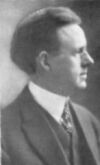 Tracy Y. Cannon, Organist (1909-1930)
Tracy Y. Cannon, Organist (1909-1930)
- He wrote the following hymns:
- "Come, Rejoice", (text and music, adapted) (Hymns, number 9, 1985).
- "God of Power, God of Right", (music) (Hymns, number 20, 1985).
- "Praise the Lord with Heart and Voice", (text and music) (Hymns, number 73, 1985).
- "The Lord Be With Us", (music) (Hymns, number 161, 1985).
- "Come, Let Us Sing an Evening Hymn", (music) (Hymns, number 167, 1985).
- "Jesus, Mighty King In Zion", (music) (Hymns, number 234, 1985).
- "How Beautiful Thy Temples, Lord", (music) (Hymns, number 288, 1985).
The first recordings of the Choir was made on 1 September 1910 for the Columbia Phonograph Company. Thirteen selections were "acoustically" recorded, including four organ pieces, two Choir members with vocal soloists, and seven by the Choir. Four additional organ recordings were made the following day.
In 1911 the Choir performs at Madison Square Garden in New York City, and for President William Howard Taft in the White House.
In 1915, year-round daily organ recitals were inaugurated.
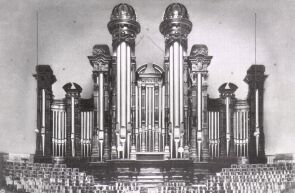 In 1915-16, the Austin Company of Hartford, Connecticut rebuilt the
tabernacle organ, preserving the original casework, and adding two
side wings, each fifteen feet wide, which harmonized with the original
design. By this time only about eight ranks of pipes from the original
set were still in use. It then had 112 sets of pipes which are divided
into seven sections or divisions and between seven and eight thousand
pipes.
In 1915-16, the Austin Company of Hartford, Connecticut rebuilt the
tabernacle organ, preserving the original casework, and adding two
side wings, each fifteen feet wide, which harmonized with the original
design. By this time only about eight ranks of pipes from the original
set were still in use. It then had 112 sets of pipes which are divided
into seven sections or divisions and between seven and eight thousand
pipes.
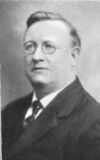 Anthony Lund, Director (1916-1935), with B. Cecil Gates and
Albert J. Southwick, assistants.
Anthony Lund, Director (1916-1935), with B. Cecil Gates and
Albert J. Southwick, assistants.
- B. Cecil Gates wrote the following:
- "How Long, O Lord Most Holy And True", (music) (Hymns, number 126, 1985).
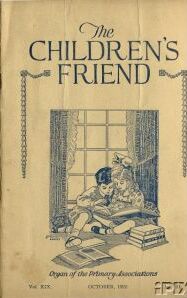 The October 1920 Children's Friend featured a story by Evan Stephens
called "The World's Fair Gold Medal" about the Tabernacle Choir going to the
World's Fair in Chicago. (volume XIX No 10)
The October 1920 Children's Friend featured a story by Evan Stephens
called "The World's Fair Gold Medal" about the Tabernacle Choir going to the
World's Fair in Chicago. (volume XIX No 10)
Alexander Schreiner, Organist (1924-1977).
- He wrote the following hymns:
- "Truth Eternal", (music) (Hymns, number 4, 1985).
- "Lead Me into Life Eternal", (music) (Hymns, number 45, 1985).
- "Thy Spirit Lord, Has Stirred Our Souls", (music) (Hymns, number 157, 1985).
- "While of These Emblems We Partake", (music) (Hymns, number 174, 1985).
- "God Loved Us, So He Sent His Son", (music) (Hymns, number 187, 1985).
- "In Memory of the Crucified", (music) (Hymns, number 190, 1985).
- "Lord, Accept into Thy Kingdom", (music) (Hymns, number 236, 1985).
- "Behold Thy Sons and Daughters, Lord", (music) (Hymns, number 238, 1985).
- "Holy Temples on Mount Zion", (music) (Hymns, number 289, 1985).
Frank Asper, Organist (1924-1963)
- He wrote the following hymns:
- "God Is in His Holy Temple", (music) (Hymns, number 132, 1985).
- "'Tis Sweet to Sing the Matchless Love", (music) (Hymns, number 176, 1985).
- "O Thou, Before the World Began", (music) (Hymns, number 189, 1985).
- "Hear Thou Our Hymn, O Lord", (text and music) (Hymns, number 222, 1985).
- "This House We Dedicate To Thee", (music) (Hymns, number 245, 1985).
- "Rejoice! A Glorious Sound Is Heard", (music) (Hymns, number 257, 1985).
- "Rise Up, O Men of God", (music) (Hymns, number 323, 1985).
In 1927 Anthony Lund directed the first "electrical" recordings of the choir for the Victor Company.
He conducted the first nationwide radio broadcast on KLS-radio (then an NBC affiliate) of "Music and the Spoken Word" on Monday, 15 July 1929, from 3:00-3:30 pm, MST, with Ted Kimball, announcer.
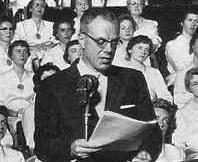 Richard L. Evans, "Spoken Word" commentator (1930-1971).
Richard L. Evans, "Spoken Word" commentator (1930-1971).
On September 15, 1932, KSL became a CBS affiliate, and the Choir's weekly
broadcast "Music and the Spoken Word" moved to Sunday morning. It still
continues as the longest uninterrupted network broadcast in American radio
history.
In April, 1933, the Columbia Broadcasting System requested that
the Choir's broadcasts be lengthened to one hour. This was done in
1933-1934, but by 1936 was modified to a 30 minute "program of choral
and organ music", and a 30 minute program of "Church Of The Air", usually
featuring two General Authority talks, with a couple of hymns.
By 1940, the familiar 30 minute "program of choral and organ music
and brief spoken comment" that we now know had taken form.
Wade Naisbitt Stephens, Organist (1933-1944)
J. Spencer Cornwall, Director (1935-1957), with Albert J. Southwick, D. Sterling Wheelwright, John R. Halliday, and Richard P. Condie, assistants.
- J. Spencer Cornwall wrote the following hymn:
- "Softly Beams the Sacred Dawning", (music) (Hymns, number 56, 1985).
Lester F. Hewlett appointed Choir President (1938-1962).
The Choir participated with Dr. Harvey Fletcher of Bell Telephone Laboratories in the first public demonstration of stereophonic sound at Carnegie Hall in New York (April, 1940).
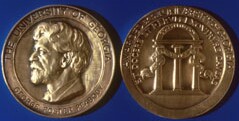 In 1943, the George Foster Peabody Award for outstanding entertainment in
music was awarded to the Tabernacle Choir, for the Sunday program, "Music and
the Spoken Word," originating in station KSL of Salt Lake City.
This award was established in 1939 and first awarded in 1940.
In 1943, the George Foster Peabody Award for outstanding entertainment in
music was awarded to the Tabernacle Choir, for the Sunday program, "Music and
the Spoken Word," originating in station KSL of Salt Lake City.
This award was established in 1939 and first awarded in 1940.
Nationwide radio memorial services for Franklin D. Roosevelt (12 April 1945)
The Choir made it's first seasonal recording for broadcast to U.S. servicemen in Europe and the Pacific on Christmas Day, 1945.
Roy Darley, Organist (1947-1984)
In 1948, under the supervision of organist Alexander Schreiner, Aeolian-Skinner rebuilt the tabernacle organ. The organ then had 11,000 pipes and 188 stops.
The Choir released its first long-playing recording in 1949.
Featured in the first "Cinerama" movie (1952)
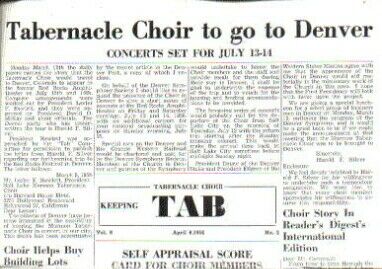 This is a copy of the April 1956 edition of "Keeping Tab".
This newsletter kept members up to date
on the things that were happening with the choir.
This is a copy of the April 1956 edition of "Keeping Tab".
This newsletter kept members up to date
on the things that were happening with the choir.
Richard P. Condie, Director (1957-1974), with Jay E. Welch, assistant.
 Sixteen-inch diameter "Radio Transcription Disks" were used to distribute
performances of "Music and the Spoken Word" to the armed forces. This
example (SERIES RED-586, SALT LAKE TABERNACLE CHOIR # 23/NEW YORK PHILHARMIC
PT. 3 PROGRAM # 223) is from 1958.
Sixteen-inch diameter "Radio Transcription Disks" were used to distribute
performances of "Music and the Spoken Word" to the armed forces. This
example (SERIES RED-586, SALT LAKE TABERNACLE CHOIR # 23/NEW YORK PHILHARMIC
PT. 3 PROGRAM # 223) is from 1958.
The recording of "The Battle Hymn of the Republic" earned the choir a Grammy award in November, 1959 in the vocal group/chorus category.
 In 1961, KSL-TV received the Peabody Award for the program "Let Freedom Ring".
This was an inspirational one-hour special program marshalling
through music and the spoken word the moral heritage that has made America
great. This patriotic expression ranged from the spirit of Patrick Henry and
Abraham Lincoln to the Battle Hymn of the Republic. It featured the Salt Lake
City Mormon Tabernacle Choir; starred Richard Boone, Laraine Day, Howard Keel,
and Don O'Herligy; was narrated by Richard L. Evans; produced by Michel M.
Grilikhes; and written by Michel M. Grilikhes and Richard L. Evans.
In 1961, KSL-TV received the Peabody Award for the program "Let Freedom Ring".
This was an inspirational one-hour special program marshalling
through music and the spoken word the moral heritage that has made America
great. This patriotic expression ranged from the spirit of Patrick Henry and
Abraham Lincoln to the Battle Hymn of the Republic. It featured the Salt Lake
City Mormon Tabernacle Choir; starred Richard Boone, Laraine Day, Howard Keel,
and Don O'Herligy; was narrated by Richard L. Evans; produced by Michel M.
Grilikhes; and written by Michel M. Grilikhes and Richard L. Evans.
Condie conducted the first television broadcast of "Music and the Spoken Word" on 14 October 1962, reaching an audience of over eight hundred radio and television stations worldwide.
Isaac M. Stewart appointed Choir President (1962-1975).
The choir performs at the inauguration of President Lyndon B. Johnson (1965).
Robert Cundick, Organist (1965-1991)
- He wrote the following hymns:
- "That Easter Morn", (music) (Hymns, number 198, 1985).
- "Thy Holy Word", (music) (Hymns, number 279, 1985).
In 1967, the Choir is featured on the long runnign NBC-TV series:
September 30-October 1 General Conference is the Choir's first color television broadcast.
The choir performs at the inauguration of President Richard M. Nixon (1969).
J. Spencer Kinard, "Spoken Word" commentator (1971-1990)
Jay Welch, Director (1974), with Jerold D. Ottley, assistant.
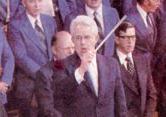 Jerold Ottley, Director (1974-1999),
with Donald H. Ripplinger, associate conductor (1974-1995).
Jerold Ottley, Director (1974-1999),
with Donald H. Ripplinger, associate conductor (1974-1995).
Dr. Ottley's optimum choir has 320 voices--168 women and 152 men:
- 84 sopranos (divided into two sections of 42)
- 84 altos (divided into two sections of 42)
- 76 tenors (divided into two sections of 38)
- 76 basses (divided into two sections of 38)
Oakley S. Evans appointed Choir President (1975).
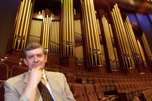 John Longhurst, Organist (1977-
John Longhurst, Organist (1977-
- He wrote the following hymns:
- "We're Not Ashamed to Own Our Lord", (music) (Hymns, number 57, 1985).
- "I Believe In Christ", (music) (Hymns, number 134, 1985).
In 1977, the Choir appeared on the Donnie & Marie Christmas show.
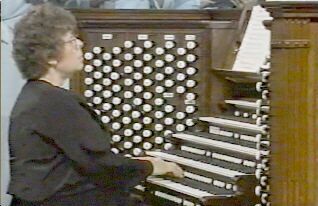
Bonnie Goodliffe, Associate Tabernacle Organist, 1979-present.
In 1980, Music and the Spoken Word, Fourth of July Broadcast, was awarded a Freedom Foundation Award,
The special "Mr. Krueger's Christmas", featuring the Choir, is aired during the week of Dec. 13-19th, 1980. (TV Guide, Vol. 28 No. 50.)
The choir performs at the inauguration of President Ronald Reagan (1981). He names it "America's Choir".
 Clay Christiansen, Organist (1982-
Clay Christiansen, Organist (1982-
- He wrote the following hymn:
- "In Fasting We Approach Thee", (music) (Hymns, number 139, 1985).
Wendell M. Smoot appointed Choir President (1983-2000).
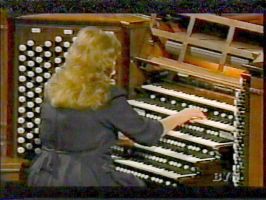 Linda Margetts, Associate Tabernacle Organist, 1984-present.
Linda Margetts, Associate Tabernacle Organist, 1984-present.
Between 1985 and 1989, Schoenstein and Co. of San Francisco directed a major renovation of the organ, regulating all pipework, rebuilding the console, and installing seventeen ranks of new pipes. It's present size is 11,623 pipes organized into 147 voices (tone colors) and 206 ranks (rows of pipes). Grouped into 8 divisions, they are controlled from a console with five 61-note manuals (keyboards) and a 32-note pedalboard. All divisions of the organ are located behind the massive casework on the west end of the Tabernacle except the antiphonal division, which is in the lower attic at the east end and speaks through openings behind the center balcony seats. The longest pipe is 32 feet in speaking length; the shortest is three-quarters of an inch. Pipes are made of wood, zinc, and various alloys of tin and lead.
In 1987, the Choir won an EMMY AWARD for "Christmas Sampler," with Shirley Verrett.
 The Choir and the Philly Pops backs up Barry Manilow on "Let Freedom Ring",
penned for the "We The People" Constitutional Gala, held at the Convention
Hall in the Philadelphia Civic Denter, which was televised in September, 1987.
The Choir and the Philly Pops backs up Barry Manilow on "Let Freedom Ring",
penned for the "We The People" Constitutional Gala, held at the Convention
Hall in the Philadelphia Civic Denter, which was televised in September, 1987.
In 1988, the Choir was honored with a Freedom Foundation citation for it's contributions in promoting patriotic pride in America.
The choir performs at the inauguration of President George Bush (1989). He calls the Choir "a national treasure".
In 1989 the Choir recieved the Rocky Mountain Region of National Academy of Television Art and Sciences, Governor's Award, for 30 years of service
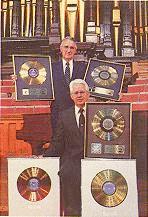 The Choir has earned five gold, and two platinum RIAA records,
an impressive achievement.
Pictured are Choir president Wendell M. Smoot (back) and director
Jerold Ottley holding some of these awards.
The Choir has earned five gold, and two platinum RIAA records,
an impressive achievement.
Pictured are Choir president Wendell M. Smoot (back) and director
Jerold Ottley holding some of these awards.
- GOLD RECORDS:
- 1963 Handel's Messiah, with Eugene Ormandy and the Philadelphia Orchestra
- 1963 The Lord's Prayer, with Eugene Ormandy and the Philadelphia Orchestra
- 1980 The Joy of Christmas, with Leonard Bernstein and the New York Philharmonic Orchestra
- 1985 The Tabernacle Choir Sings Christmas Carols, Richard Condie, Conductor
- 1985 Joy to the World, with Richard Condie and the Philadelphia Brass Ensemble and Percussion
- PLATINUM RECORDS:
- 1991 Carols of Christmas, Hallmark
- 1992 Celebrate Christmas, Hallmark
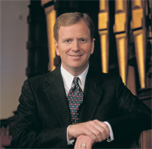 Lloyd Newell, "Spoken Word" commentator (1990-
Lloyd Newell, "Spoken Word" commentator (1990-
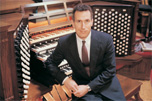 Richard Elliott, Organist (1991-
Richard Elliott, Organist (1991-
In 1991 the Choir performs in Eastern Europe and the former Soviet Union.
In December 1992-January 1993 the Choir performs in Israel.
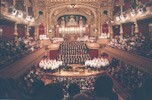 In 1998, the Choir toured parts of Europe.
In 1998, the Choir toured parts of Europe.
Craig Jessop, associate director (1995-1999)
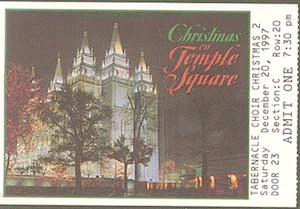 The Tabernacle Choir has hosted a series of Christmas concerts in
recent years. Many of these concerts have resulted in albums and television
specials. The 1997 concert was released
as a PBS special and
as a recording.
The Tabernacle Choir has hosted a series of Christmas concerts in
recent years. Many of these concerts have resulted in albums and television
specials. The 1997 concert was released
as a PBS special and
as a recording.
Mack Wilberg, associate director (1999-2008)
Dr. Mack Wilberg was appointed director of the Temple Square Chorale and
associate director of the Mormon Tabernacle Choir in May 1999.
 Barlow Bradford, associate director (1999-2003)
Dr. Barlow Bradford was appointed director of the Orchestra at Temple Square
and associate director of the Mormon Tabernacle Choir in May 1999. He
received his master's degree in orchestral conducting and his doctorate in
musical arts from the University of Southern California, where he was voted
by the faculty as Most Outstanding Student in conducting and keyboard
collaborative arts. Before his appointment to the choir, Bradford was the
founder and artistic director of Utah Chamber Artists and director of
orchestras at the University of Utah. As a conductor he has performed and
recorded with the Israel Chamber Orchestra, Utah Symphony and Utah Chamber
Artists. As a composer and arranger he has had his works performed and
recorded by the Utah Symphony and Utah Chamber Artists. As a pianist he has
performed throughout the United States and England.
Barlow Bradford, associate director (1999-2003)
Dr. Barlow Bradford was appointed director of the Orchestra at Temple Square
and associate director of the Mormon Tabernacle Choir in May 1999. He
received his master's degree in orchestral conducting and his doctorate in
musical arts from the University of Southern California, where he was voted
by the faculty as Most Outstanding Student in conducting and keyboard
collaborative arts. Before his appointment to the choir, Bradford was the
founder and artistic director of Utah Chamber Artists and director of
orchestras at the University of Utah. As a conductor he has performed and
recorded with the Israel Chamber Orchestra, Utah Symphony and Utah Chamber
Artists. As a composer and arranger he has had his works performed and
recorded by the Utah Symphony and Utah Chamber Artists. As a pianist he has
performed throughout the United States and England.
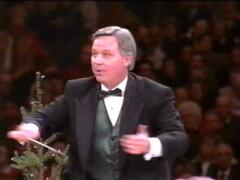 Craig Jessop, Director (1999-2008)
Craig Jessop, Director (1999-2008)
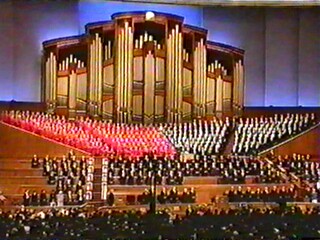 Since April 2000, the Choir has sung for the twice annual General Conference
of the Church of Jesus Christ of Latter-Day Saints in the new "Conference
Center" on the block North of Temple Square.
On most Sundays, the weekly Choir
broadcast will continue from the Tabernacle on Temple Square.
Since April 2000, the Choir has sung for the twice annual General Conference
of the Church of Jesus Christ of Latter-Day Saints in the new "Conference
Center" on the block North of Temple Square.
On most Sundays, the weekly Choir
broadcast will continue from the Tabernacle on Temple Square.
F. MacRay Christensen appointed Choir President (November 12, 2000)
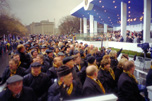 The choir performs at the inauguration of President
George W. Bush (2001).
The choir performs at the inauguration of President
George W. Bush (2001).
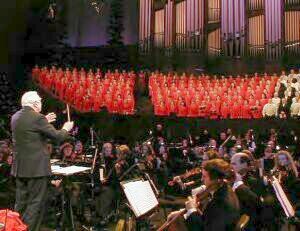 Walter Cronkite directed the Hallelujah Chorus during the 2002 Christmas
Concert.
Walter Cronkite directed the Hallelujah Chorus during the 2002 Christmas
Concert.
 In 2003, Igor Gruppman was named Conductor of the Orchestra at Temple Square.
In 2003, Igor Gruppman was named Conductor of the Orchestra at Temple Square.
 On November 12th, 2003, the United States' highest honor for artistic
excellence was awarded to the Choir, in a special ceremony held in The
White House. Established in 1984, the medal is awarded annually by the
President to individuals and organizations that have made extraordinary
contributions to the creation, support, and growth of the arts in the
United States.
On November 12th, 2003, the United States' highest honor for artistic
excellence was awarded to the Choir, in a special ceremony held in The
White House. Established in 1984, the medal is awarded annually by the
President to individuals and organizations that have made extraordinary
contributions to the creation, support, and growth of the arts in the
United States.
The National Association of Broadcasters (NAB) has announced that the Mormon Tabernacle Choir's long-time radio program Music and the Spoken Word will be inducted into the NAB Broadcasting Hall of Fame during its NAB2004 annual convention in Las Vegas on April 20, 2004.
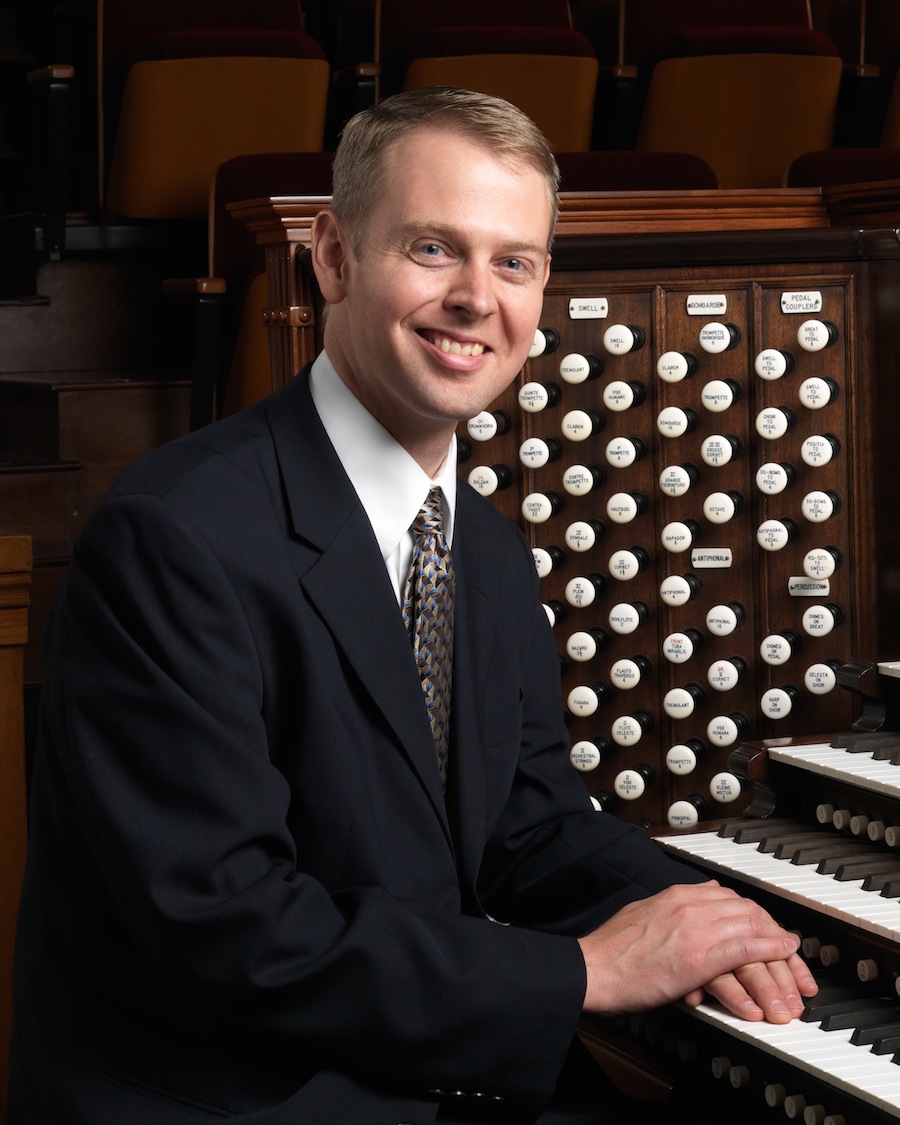 Andrew E. Unsworth, Organist (2007-
Andrew E. Unsworth, Organist (2007-
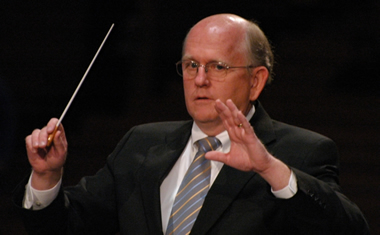 Mack Wilberg, Director (2008-present)
Dr. Mack Wilberg was appointed director of the Mormon Tabernacle Choir in May 2008, after
Craig Jessop resigned in March. Wilberg is
the former director of choral activities at Brigham Young University (BYU)
in Provo, Utah, where he conducted the Concert Choir and the 240-voice Men's
Chorus. In addition to his conducting responsibilities, he taught graduate
and undergraduate music courses at BYU. Wilberg is an active concert pianist,
chamber musician, clinician, composer, arranger and guest conductor
throughout the United States and abroad. His compositions and arrangements
are consistently performed and recorded throughout the world and published
by Oxford University Press and Hinshaw Music. Wilberg received his master's
and doctorate of musical arts degrees from the University of Southern
California and completed his undergraduate studies at BYU.
Mack Wilberg, Director (2008-present)
Dr. Mack Wilberg was appointed director of the Mormon Tabernacle Choir in May 2008, after
Craig Jessop resigned in March. Wilberg is
the former director of choral activities at Brigham Young University (BYU)
in Provo, Utah, where he conducted the Concert Choir and the 240-voice Men's
Chorus. In addition to his conducting responsibilities, he taught graduate
and undergraduate music courses at BYU. Wilberg is an active concert pianist,
chamber musician, clinician, composer, arranger and guest conductor
throughout the United States and abroad. His compositions and arrangements
are consistently performed and recorded throughout the world and published
by Oxford University Press and Hinshaw Music. Wilberg received his master's
and doctorate of musical arts degrees from the University of Southern
California and completed his undergraduate studies at BYU.
Ed Thompson, former head of the Music Department at the University of Utah and
former conductor of the Utah Symphony Chorus, served as his interim assistant until March, 2009.
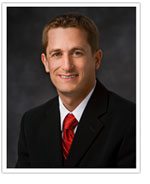
Ryan T. Murphy, associate director (March, 2009-present)
Murphy has extensive choral conducting and professional musical theater experience.
He currently conducts six choirs in the Boston area, including two choirs at
the prestigious New England Conservatory of Music. He serves as the choral director at
the Walnut Hill School for the Arts, an internationally recognized secondary school
affiliated with the New England Conservatory.
He has served as the music director for the Tuacahn theatre in the St. George, Utah, area
and prior to that as the music director for five seasons at the Sundance Institute in Provo, Utah.
He has maintained an active performing schedule, including recent collaborations at
the Tanglewood Summer Festival outside of Boston.
Ryan is presently working on his doctorate in choral conducting at Boston University and will finish his degree in May.
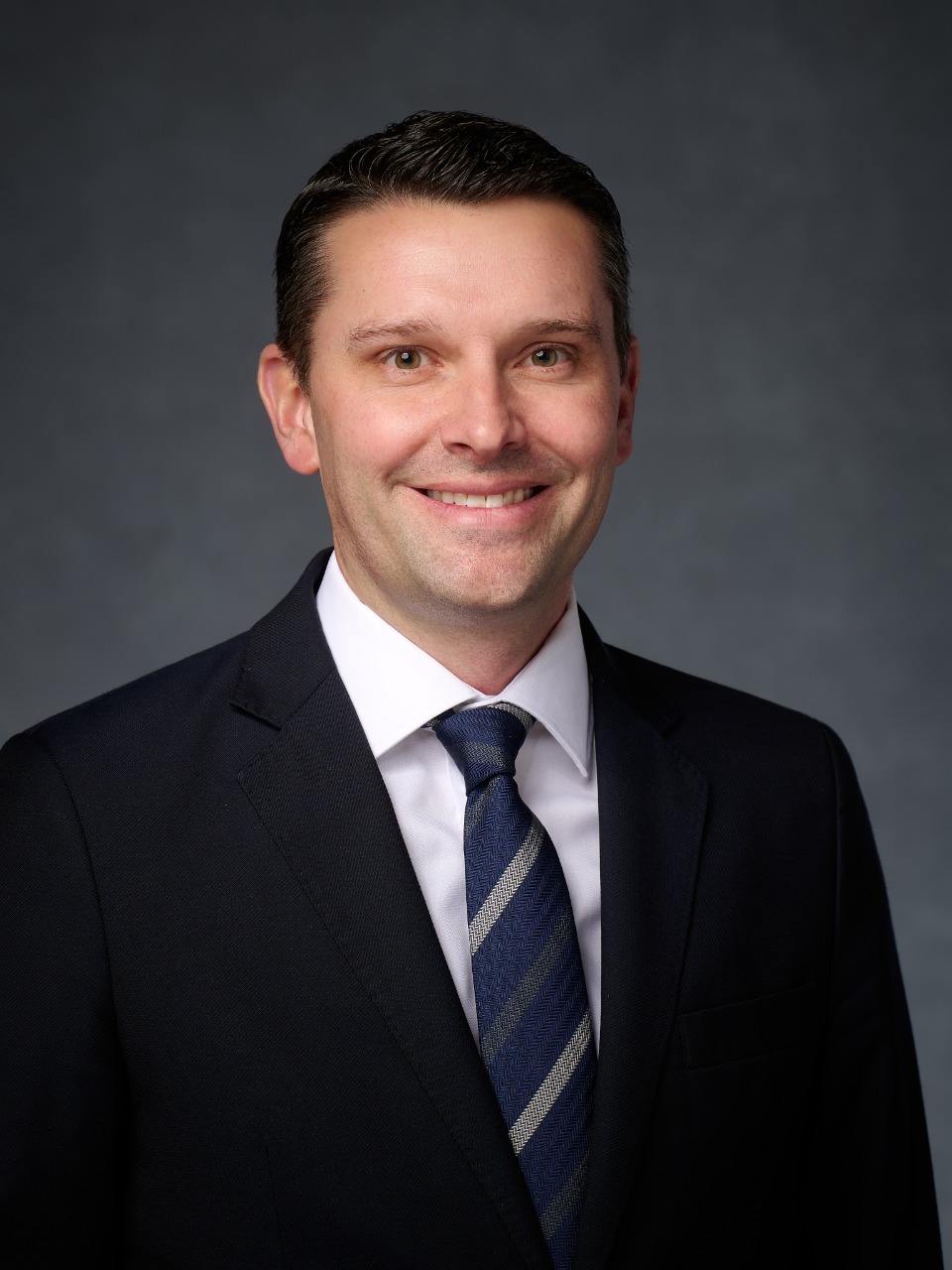 Derrick PorterMarch, 2024
Derrick PorterMarch, 2024
Top | Home | Frequently Asked Questions | Guestbook
All contents Copyright 1997-2009 by
